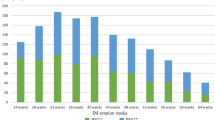Abstract
OBJECTIVE: To evaluate and compare the readiness of academic general internal medicine physicians and academic family medicine physicians to perform and teach 13 common ambulatory procedures.
DESIGN: Mailed survey.
SETTING: Internal medicine and family medicine residency training programs associated with 35 medical schools in 9 eastern states.
PARTICIPANTS: Convenience sample of full-time teaching faculty.
MEASUREMENTS AND MAIN RESULTS: A total of 331 general internists and 271 family physicians returned completed questionnaires, with response rates of 57% and 65%, respectively. Academic generalists ranked most of the ambulatory procedures as important for primary care physicians to perform; however, they infrequently performed or taught many of the procedures. Overall, compared with family physicians, general internists performed and taught fewer procedures, received less training, and were less confident in their ability to teach these procedures. Physicians’ confidence to teach a procedure was strongly associated with training to perform the procedure and performing or precepting a procedure at least 10 times per year.
CONCLUSIONS: Many academic general internists do not perform or precept common adult ambulatory procedures. To ensure that residents have the opportunity to learn routine ambulatory procedures, training programs may need to recruit qualified faculty, train current faculty, or arrange for academic specialists or community physicians to teach these skills.
Similar content being viewed by others
References
Association of American Medical Colleges. AAMC policy on the generalist physician. Acad Med. 1993;68:1–6.
American College of Physicians Task Force on Physician Supply. The role of the future general internist defined. Ann Intern Med. 1994;121(8):616–22.
Schroeder S, Showstack J, Gerbert B. Residency training in internal medicine: time for a change? Ann Intern Med. 1986;104:554–61.
Cantor JC, Baker LC, Hughes RG. Preparedness for practice—young physicians’ views of their professional education. JAMA. 1993;270(9):1035–40.
Coodley GO, Elliot DL, Goldberg L. Internal medicine training in ambulatory gynecology. J Gen Intern Med. 1992;7:636–9.
Mandel JH, Rich EC, Luxenberg MG, Spilane MT, Kern DC, Parrino TA. Preparation for practice in internal medicine. A study of ten years of residency graduates. Arch Intern Med. 1988;148:853–6.
Reuben DB, McCue JD, Gerbert B. The residency-practice training mismatch—a primary care education dilemma. Arch Intern Med. 1988;148:914–9.
Wigton RS, Nicolas JA, Blank LL. Procedural skills of the general internist—a survey of 2500 physicians. Ann Intern Med. 1989;111(12):1023–34.
Wigton RS, Blank LL, Nicolas JA, Tape T. Procedural skills training in internal medicine residencies—a survey of program directors. Ann Intern Med. 1989;111:932–8.
American Medical Association. Graduate Medical Education Directory. Chicago, IL: JAMA; 1998–1999.
Federated Council of Internal Medicine Task Force. Graduate Education in Internal Medicine—A Resource Document. Philadelphia, PA: American College of Physicians; 1996.
Nolan JP, Inui TS. Tinkering or real reform? The choice is ours. Ann Intern Med. 1992;116(12 pt 2):1042–45.
American Board of Internal Medicine. Policies and Procedures for Certification. 1997.
Cohen JJ. Roles of various organizations in internal medicine curriculum reform. Ann Intern Med. 1992;116(12 pt 2):1111–5.
Fallon HJ. Residency reform: a perspective from the Association of Professors of Medicine. Ann Intern Med. 1992;116(12 pt 2):1041.
Mullan F, Politzer RM, Gamliel S, Rivo ML. Balance and limits: modeling graduate medical education reform based on recommendations of the Council on Graduate Medical Education. Milbank Q. 1994;72(3):385–98.
Ramsey P. An update on the APM Medical Education Curriculum Committee. Am J Med. 1994;96:I-VII.
Simons R, Reynolds H. New imperatives for internal medicine residency education. Amer J Med. 1993;96:I-III.
Halperin A, Kaufman A. Ambulatory medical education: a reconsideration of sites and teachers. J Gen Intern Med. 1990;5(suppl):S35-S44.
Wartman SA, O’Sullivan PS, Cyr MG. Ambulatory-based residency education: improving the congruence of teaching, learning, and patient care. Ann Intern Med. 1992;116(12 pt 2):1071–5.
Al-Turk M, Susman J. Perceived core procedural skills for Nebraska family physicians. Fam Prac Res J. 1992;12(3):297–303.
Heikes LG, Gjerde CL. Office procedural skills in family medicine. J Med Educ. 1985;60:444–53.
Wigton RS, Steinmann WC. Procedural skills training in the internal medicine residency. J Med Educ. 1984;59:392–400.
Wigton RS. Training internists in procedural skills. Ann Intern Med. 1992;116(12 pt 2):1091–3.
American Medical Association. Graduate Medical Education Directory. Chicago, Ill: AMA;1994–1995.
Scott S, Goldberg M, Mayo N. Statistical assessment of ordinal outcomes in comparative studies. J Clin Epidemiol. 1997;50(1):45–55.
Stokes ME, Davis CS, Koch GG. Categorical Data Analysis Using the SAS system. Cary, NC: SAS Institute, Inc; 1995.
Health Resources and Services Administration. Council on Graduate Medical Education. Third report: US Department of Health and Human Services PHS; Improving Access to Health Care Through Physician Workforce Reform. Washington, DC: 1992.
Burke W, Baron RB, Lemon M, Losh D, Novack A. Training generalist physicians: structural elements of the curriculum. J Gen Intern Med. 1994;9(suppl 1):S23-S30.
Noble J. General internal medicine: at the core or on the periphery? Ann Intern Med. 1992;116(12 pt 2):1058–60.
American College of Physicians. Learning From Practitioners: Office-based Teaching of Internal Medicine Residents. Philadelphia, PA: American College of Physicians; 1995.
Corrigan JM, Thompson LM. Involvement of health maintenance organizations in graduate medical education. Acad Med. 1991;66(11):656–61.
Fogelman AM. Impact of managed care on departments of internal medicine. Am J Med. 1994;96:I-V.
Kimball HR, Young PR. Educational resource sharing and collaborative training in family practice and internal medicine. JAMA. 1995;273(4):320–2.
Author information
Authors and Affiliations
Corresponding author
Additional information
This work was supported in part by grant 2D28PE54004 from the Bureau of Health Professions, Health Resources and Services Administration, to the Faculty, Development Program for General Internal Medicine, University of North Carolina at Chapel Hill, and by Grant 52285 from the Summa Health System, Akron, Ohio.
Rights and permissions
About this article
Cite this article
Wickstrom, G.C., Kelley, D.K., Keyserling, T.C. et al. Confidence of academic general internists and family physicians to teach ambulatory procedures. J GEN INTERN MED 15, 353–360 (2000). https://doi.org/10.1046/j.1525-1497.2000.04109.x
Issue Date:
DOI: https://doi.org/10.1046/j.1525-1497.2000.04109.x




